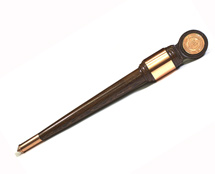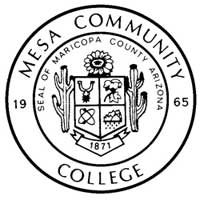 Ceremonial Mace
Ceremonial Mace
Ceremonial Mace
Ceremonial Mace
The mace was originally a weapon of offense, carried into battle by princes and medieval bishops. During the Middle Ages, the mace became a more elaborate weapon and by the fourteenth century had become a symbol of lawful authority carried by city mayors and college rectors. Like the rector of the medieval university, the modern college president is charged with protection of the special mission that society has vested in higher education. The ceremonial mace has thus emerged as a symbol of the authority of the president in acquisition, preservation, and transmission of knowledge by the college in a service to society.
The mace also symbolizes the academic sovereignty of the college and serves as notice that the president, vested with academic authority by the Governing Board, will act to preserve and protect the mission of the college. The mace is only used in official commencement ceremonies.
Mesa Community College's first mace was designed in 1989 by Gordon Benson. Prior to 1989 the college did not have a mace. Benson, a retired MCC employee, was the Associate Dean of Records and Registration.
 College Seal
College Seal
College Seal
College Seal
MCC’s official seal is a modified version of the Seal of Maricopa County and was used as a college logo prior to the development of the current logo. The seal is used only on formal or official documents, such as diplomas and transcripts.
Icons on the Seal:
The seal's outer ring displays the words, Mesa Community College with the date 1965, referring to the year MCC was found by action of the MCCCD Governing board. The inner seal encloses a shield divided into four sections bearing separately (from top left reading clockwise) a spur, a ball of cotton, a range of mountains and an electronic symbol. Beneath the shield is a banner bearing the date of 1871, the year Maricopa County was created by the Arizona Territorial government. On top of the shield is a saguaro blossom, the state flower of Arizona, representing the State from which the county derives its powers. The shield is flanked on either side by a saguaro cactus in bloom. The original Maricopa County Seal (not MCC's) was designed by Paul Coze, French Consul, artist and expert in heraldry.
Academic Regalia
The gowns worn at traditional graduation ceremonies date back to at least the thirteenth century, when most professors were clergymen and were obliged by canon law to wear robes. The associate's and bachelor's gowns hang only to the knee, have pointed sleeves, no hood or neckpiece, and a square-top cap with a tassel in winter black or the color of the discipline. The master's gown has closed sleeves, the arm coming through a slit in the elbow, a square cap with a black tassel, and a hood in the color of the discipline. The doctor's gown is distinguished by three bars on each sleeve, a hood with colorful lining, and a square cap with a gold tassel. The velvet trim of the doctor's gown and hood has colors representative of the discipline of learning of the individual, for example white for arts and letters, light blue for education, orange for engineering, pink for music, dark blue for philosophy, and golden yellow for science. Many universities, especially those in Europe, have distinctive gowns, caps, and hoods.

